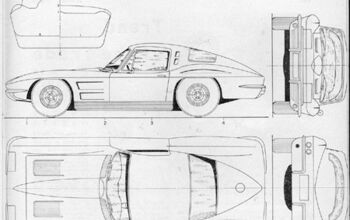General Motors Death Watch 240: 59 Days to C11
Most auto industry observers have lauded President Obama’s decision to defenestrate GM CEO Rick Wagoner and his Board of Bystanders. Their logic is as simple as one, two, three. One: U.S. taxpayers have “loaned” The General billions of dollars. Two: GM’s management failed to provide a viable viability plan to return the money. Three: the presidential putsch protects America’s “investment” in General Motors. Yes, well, protect THIS. When GM files for bankruptcy 59 days hence, $17.4 to $19.5 billion worth of taxpayer money will disappear down a rathole, never to return. That’s a conservative estimate of the total amount of federal “loans” and grants and God-knows-what that will be wiped out the moment the judge signs GM’s C11 papers. Oh, and after we kiss that cash goodbye, U.S. taxpayers will provide the cratered car maker with debtor-in-possession financing. In other words, more money. And who’s to say that money will ever be repaid? What’s the end game? Is there one?
President Obama justified his intervention in the American automobile industry with a vision of a revitalized General Motors. (Chrysler not so much.) With Uncle Sam’s help, GM will one day rise again. It will produce the clean-running, high mileage vehicles of the future, built right here in the U.S. by yada yada yada. Seriously? Does anyone seriously believe that a post-Chapter 11 General Motors will build and sell products that will be the envy of the world?
Post-C11, GM will trim down to two brands: Chevrolet and Cadillac. Costs will be cut to the bone. The United Auto Workers’ power will be denuded. Legacy issues? Banished. Bloated dealer network? Decimated. GM may even emerge from C11 with a Mulally-like leader and a fiercely independent and intelligent Board of Directors; ready, willing and able to reinvent GM’s poisonous corporate culture. And then . . . GM will face a leaner, hungrier, larger Honda, Nissan, Toyota, Hyundai, VW and Ford.
Good luck with that.
Once upon a time, GM could have entered bankruptcy, cleaned its own clock and survived. The talent locked-up inside the artist formerly known as the world’s largest automaker could have been refocused, redeployed and redirected. But CEO Rick Wagoner couldn’t see the diem, never mind carpe it. His delay and denial made GM’s recovery both more expensive and less likely.
Amongst other Shiva-like maneuvers, Wagoner created four sales “channels” for GM’s eight stricken car brands, trading internecine warfare for outright paralysis. As resources diminished, the key question—who makes what for whom when, where, why and at what price point—became a Gordian knot. “Why” became “why not” became “whatever.” A Cadillac sports wagon? You betcha. GM’s last next big thing, the pedestal-dwelling plug-in hybrid Chevrolet Volt, is the poster boy for the company’s headless chickenism.
And now, nothing. GM Car Czar Bob Lutz has retreated into the shadows, counting the days until he collects his bankruptcy-proof pension, watching as the company’s creative process (such as it is) slips into chaos. Meanwhile, GM’s Best and Brightest have left the building. The Presidential Task Force on Automobiles (PTFOA) rightly ripped Red Ink Rick’s ridiculous rabble a new REDACTED, but their “restructuring fact sheet” makes one wonder about their ability steer a course into the future. What’s the plan, Stan?
“The new GM will have a significant focus on developing high fuel-efficiency cars that have broad consumer appeal because they are cost-effective, have good performance and are reliable, durable and safe.” PC it may be, but that hardly sounds like an ideal recipe for world-class Cadillacs. Which leaves Chevrolet. Trying to play catch-up with battle-hardened, technologically adept, customer retaining competition.
Again, good luck with that.
Fifty-nine days from today, GM will file for C11. Chevy and Cadillac will eventually emerge from the rubble. The chosen ones will survive until they come off the federal teat. They may even survive after that. But they will be damaged brands—welfare queens tainted by their association with the federal government. Even if Chevrolet and Cadillac create world-beating products with industry-leading customer service, they will have the stench of corruption. Their logos will be a malodorous reminder that they achieved their success off the backs of the American taxpayer, rather than honest labor.
OK, maybe that’s a bit much. Americans love a comeback kid. And what late 1940s industry expert could have predicted that his fellow countrymen would elevate Japanese brands to the top of the family and luxury car sales charts? But do we really have to pay twice for GM’s resurrection?
If General Motors had filed for Chapter 11 when they coulda shoulda, no tax money would have been harmed in the making of this [entirely theoretical] renaissance. As it currently stands, there is no end point. Sure, Chrysler repaid its loans way back when and . . . oh dear. Despite all that government help they’re in a bit of mess now aren’t they? You know, in a DOA sort of way. So maybe, just maybe, government assistance is a form of assisted suicide. Perish the thought.
More by Robert Farago
Latest Car Reviews
Read moreLatest Product Reviews
Read moreRecent Comments
- Carson D I thought that this was going to be a comparison of BFGoodrich's different truck tires.
- Tassos Jong-iL North Korea is saving pokemon cards and amibos to buy GM in 10 years, we hope.
- Formula m Same as Ford, withholding billions in development because they want to rearrange the furniture.
- EV-Guy I would care more about the Detroit downtown core. Who else would possibly be able to occupy this space? GM bought this complex - correct? If they can't fill it, how do they find tenants that can? Is the plan to just tear it down and sell to developers?
- EBFlex Demand is so high for EVs they are having to lay people off. Layoffs are the ultimate sign of an rapidly expanding market.


































Comments
Join the conversation
the comments you all have been leaving display a rightful sense of outrage. however, GM CANNOT be allowed to go bankrupt at the present time for a number of reasons. the first, is while you all seem to be blaming the uaw and "poisonous" corporate structure for the economic situation you have failed to remember that all of these "evil" entities are actually people. sure there may be largesse reminiscent of an earlier time, but would you want to take a demotion at YOUR job if your company needed the money, and don't lie to yourself. second, one has to consider where those billions are actually going. they are not going into the hands of the corporate fat cats, this money is coming right back to you through the purchases of the retirees whom this money keeps afloat. this money pays the workers who buy things that keeps our heavily consumer based society functioning. Futhermore, this number of workers is not inconsequential. if one considers the "bloated" dominantly AMERICAN owned dealer network employees, the massive number of support businesses which supply GM with parts and services, and finally the workers of GM itself more than a couple of million people could face unemployment due to bankruptcy. this is a massive number. it is only a few percent of the US's economy, but if you liken the economy to global warming. 1.5 degrees (the current global change attributed to man) is enough to begin to change the whole world. similarly those few points of unemployment combined with the money lost from incomes WILL launch the us into the next GREAT DEPRESSION. so unless you want to loose your job with 30% or so of the worlds denizens read a macro economics textbook, a history book and stop bellyaching. this money is literally buffering our whole economy. for those of you who don't know the programs in the government that are considered the most influential on quality of life in America (social security, medicare, medicaid) are all products of FDR's new deal. these programs and other now defunct programs likewise spent exorbitant sums of tax payer money bailing out businesses and people during the great depression. the punchline is that sure the tax payer may have to bail out some large businesses, but they are simply to central to our nation's economic structure to fail regardless of bad management. as a closing point, were our major companies to fail consider the huge negative trade balance that would result. as the saying goes money literally does not grow on trees we can and will run out and all be poor ( see the foreign oil argument.)